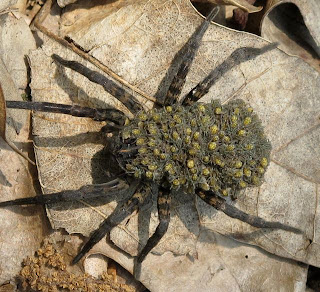Today, Saturday, August 20, at Campshore Campground in Ohio County, Indiana (812-438-2135), the 15th Annual "Snapperfest" will take place. Here's Timothy Sizemore, the proprietor of Campshore Campground, holding the unfortunate focal point of the "festival." The highlight of the event is when contestants reach into a horse trough of murky water, pull out a snapping turtle by its tail, slam it on a mat, pound on its shell to further terrify it, then brutally yank its head out without losing a finger. But they're not done yet. A successful contestant wraps the turtle's neck around his wrist and holds it up over his head, asserting his dominance over the terrified and by now perhaps mortally injured turtle. The crowd, composed of families with lots of children, sends up a roar of approval for a successful contestant. What message does that send to the children? Fifteen years of this...how many rural Indiana, Ohio and Kentucky kids have grown up thinking that's an awesome thing to do?
If you can stand to watch, here's the video. http://www.ebaumsworld.com/video/watch/81767472/
Ohio County, Indiana, whose only incorporated town is Rising Sun, is right over the line from Cincinnati. You'd think that this kind of thing would have already gone the way of cockfighting, bull-baiting and Vick-style pitbull fights. But no. Who loves a snapping turtle? Who empathizes with a vicious, dangerous, cold-blooded monster of the deep that eats the fish we like to haul out on our lines? I'm figuring you do. I sure do. People like us move them off the road when they're in peril.
When we first moved to Marietta, Ohio, I went to the Washington county fair. And there was an event called a Turtle Race. Wild-caught box turtles were placed in the middle of a circle drawn in the dirt, and the owner of the first turtle to leave the circle "won." When I saw more than a dozen of these animals, abducted from their woodland habitat and plunked down in the blazing sun for a frivolous competition, Bill had to physically restrain me and carry me from ringside. I couldn't stop it that year, but I damn sure stopped it the next year. I wrote letters, I made calls; I was shouted at, hung up on and accused of spoiling harmless children's fun; of harassing members of the Fair Board. Tough. I kept my eye on the prize, because I knew I had truth and compassion on my side. The box turtle a native wildlife species that is rapidly declining and threatened by habitat loss and human exploitation. It isn't a toy. And the Fair Board had no good rejoinder to that.
A few years later, when Washington County Fair carnival concessions were offering hatchling red-eared slider turtles and (horror of horrors) baby green iguanas as prizes, I went back into action. This time, my first call was to the Washington County Health Department, which quickly responded to my assertion that both water turtles and iguanas are known salmonella vectors, and hardly suitable as children's prizes at a fair. Shut them down that time, too. A few well-placed, polite calls shored up with factual information go a long way.
Indiana law states that a person who knowingly, intentionally beats a vertebrate animal commits a Class A misdemeanor.
I note that Campshore Campground's proprietor Timothy Sizemore's favorite saying on his public Facebook profile is "What goes around comes around, do unto others......" He also describes himself as "honest, straightforward, compassionate, emotional, sincere."
A snapping turtle is not a toy. It is a sentient vertebrate being, capable of feeling fear and pain. This "festival" needs to go the way of bull-baiting, cockfighting and pitbull fighting. We've apparently learned nothing from Michael Vick's example.
Call the Ohio County Sheriff at 812-438-3636.
Call the Campshore Campground at 812-438-2135.
Even if you get an answering machine or a busy signal, keep calling. Make it more trouble for them than it's worth to hold this brutal event. Tell them the world is watching.
Here's my letter:
Dear (insert public official here)
I am a writer, naturalist, and wildlife rehabilitator who works with turtles in southeast Ohio. I have just become aware of "Snapperfest," and I've viewed video of live snapping turtles being very roughly handled by people in a contest. As one who spends years and quite a bit of my own funds healing turtles that have been hit by cars and mowers, or kept in captivity by people, the notion of using living animals in a contest to subdue them literally sickens me. This is a barbaric thing, which must go the way of bull baiting, cockfighting and pit bull fights. Have we learned nothing from Michael Vick's example? Turtles are not toys, and the regrettable fact that most people hate snapping turtles doesn't make this any less cruel and barbaric. Snapping turtles are native wildlife, and must be treated with respect. This event reflects very badly on Indiana, on Ohio County, and on officials who turn a blind eye to an illegal and extremely inhumane activity.
Looking into Indiana law, we find:
Information Maintained by the Office of Code Revision Indiana Legislative Services Agency
IC 35-46-3
Chapter 3. Offenses Relating to Animals…
IC 35-46-3-8
…Purchase or possession of animals for contests
Sec. 8. A person who knowingly or intentionally purchases or possesses an animal for the purpose of using the animal in an animal contest commits a Class D felony.
As added by P.L.193-1987, SEC.11. Amended by P.L.171-2007,
IC 35-46-3-0.5
Definitions
(2) "Beat" means to unnecessarily or cruelly strike an animal, or to throw the animal against an object causing the animal to suffer severe pain or injury. The term does not include reasonable training or disciplinary techniques.
(3) "Mutilate" means to wound, injure, maim, or disfigure an animal by irreparably damaging the animal's body parts or to render any part of the animal's body useless.
I would be surprised if any of the snapping turtles used in violation of Indiana law in this contest are viable or releasable after such severe abuse. Please stop this event, or be prepared to receive the outrage of many thousands of people who respect native wildlife and will not suffer its torture for fun or profit.
Sincerely,
Julie Zickefoose
Compose your own letter and fire it off to:
The Honorable Connie J. BrownOhio County Commissioner
yvonnewalton@hotmail.com
The Honorable Todd Walton
Ohio County Commissioner
twalton@cinergy.com
The Honorable Connie Smith
Ohio County Auditor
ohioctyauditor1@earthlink.net
Campshore Campground
812-438-2135 (office)
812-290-5939 (cell)
info@campshorecampground.com
Councilman Pro-Tem Mike Padgett
mpadgett@orvcomm.com
(812) 438-3340
Councilman Steve Slack
sslack@orvcomm.com
(812) 438-3340
Councilman Lynn Graves
lgraves@orvcomm.com
(812) 438-3340
Councilman Bud Radcliff
bradcliff@orvcomm.com
(812) 438-3340
Councilman Roy Powell
rpowell@orvcomm.com
(812) 438-3340
AND: Sign the petition, "Stop Snapperfest" at change.org.




















































